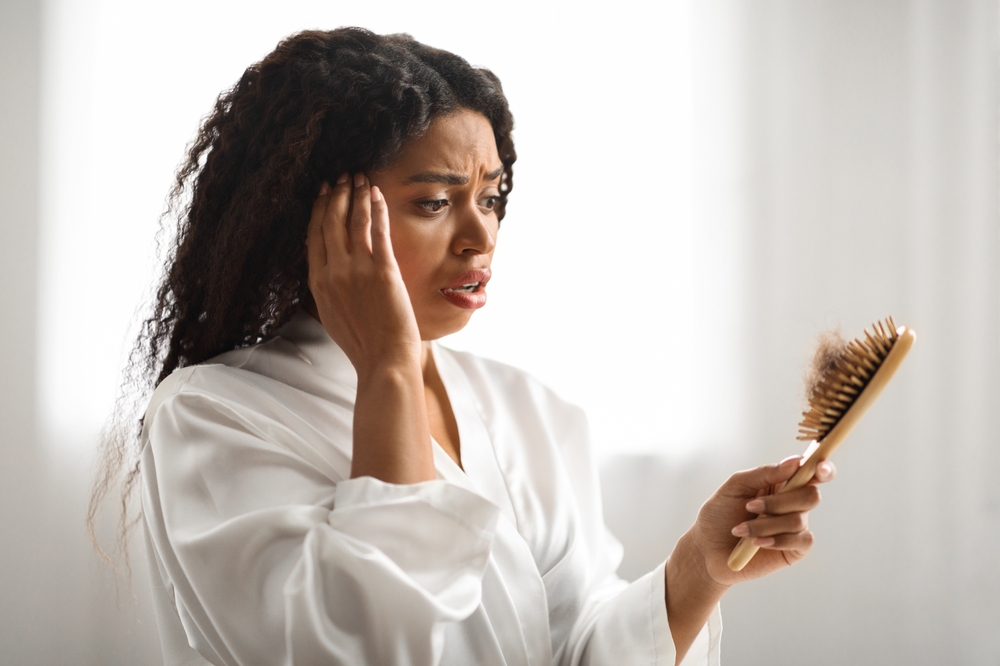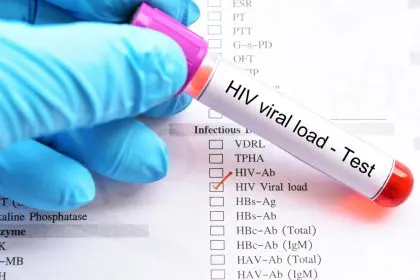Finding more hair than usual on your pillow or watching your ponytail gradually shrink in diameter can be alarming enough on its own. But what if that hair loss is actually a visible signal of something happening deeper in your body? For millions of people, thinning hair isn’t just a cosmetic concern – it’s the visible tip of a thyroid imbalance iceberg.
That butterfly-shaped gland in your neck might be tiny, but it produces hormones that influence virtually every cell in your body, including those in your hair follicles. When thyroid function goes awry, one of the first places you might notice changes is in your hair’s appearance, thickness, and growth patterns.
The hair growth cycle thyroid hormones control
To understand how thyroid issues affect your hair, you need to know a little about how hair normally grows. Each strand on your head follows a predictable growth cycle with three main phases – the active growing phase (anagen), the transitional phase (catagen), and the resting phase (telogen).
Normally, about 85-90% of your hair is in the growing phase at any given time, with the rest either transitioning or resting. This staggered cycle is why you don’t normally shed all your hair at once – only the strands that have completed their growth cycle and entered the resting phase fall out naturally.
Thyroid hormones play a crucial role in regulating this cycle. They help determine how long each hair stays in the growth phase and how quickly your follicles can regenerate new hairs after shedding. When thyroid hormone levels are balanced, this cycle proceeds smoothly, with minimal noticeable hair loss.
But when thyroid hormone production goes too high or too low, this delicate cycle gets disrupted. Hair may shift prematurely from the growing phase into the resting phase, leading to more hairs being shed than usual. Or the growth phase may slow down, resulting in thinner, more fragile strands that break easily.
What hypothyroidism does to your locks
Hypothyroidism – when your thyroid doesn’t produce enough hormones – is one of the most common thyroid conditions, especially in women. This hormonal deficit essentially puts your body’s metabolic processes in slow motion, including those that control hair growth.
When your thyroid is underactive, hair follicles can get stuck in the resting phase, unable to cycle back to active growth. This leads to hair that falls out at the normal rate but isn’t replaced quickly enough, resulting in progressive thinning that becomes noticeable over months.
The hair that does grow during hypothyroidism often has a different texture than your normal hair. Many people notice their hair becoming unusually dry, brittle, and dull. It might break more easily, fail to grow as long as it used to, or feel strangely coarse between your fingers.
Perhaps most tellingly, hypothyroidism-related hair loss typically doesn’t follow the pattern you’d expect from genetic baldness. Instead of a receding hairline or crown thinning, people with hypothyroidism often experience diffuse thinning across the entire scalp. You might notice your part widening or your hairline looking sparse all over rather than in specific areas.
Another distinctive sign that low thyroid could be behind your hair issues is loss of the outer third of your eyebrows. This peculiar symptom – where the tail end of your eyebrows gradually disappears – is so strongly associated with hypothyroidism that doctors often look for it during physical exams.
When hyperthyroidism speeds up hair shedding
On the flip side, hyperthyroidism – when your thyroid produces too much hormone – creates the opposite problem. Rather than slowing your body down, excess thyroid hormone kicks everything into overdrive, including your hair cycle.
With hyperthyroidism, hair follicles can be rushed through their growth cycle too quickly. This accelerated cycling means hairs don’t have time to grow to their full potential before moving into the falling out phase. The result is often fine, thin hair that sheds abundantly.
People with hyperthyroidism might notice sudden, dramatic shedding where hair comes out in handfuls rather than the gradual thinning seen with hypothyroidism. You might see more hair in your shower drain, on your pillow, or in your hairbrush than ever before.
The texture of hair changes with hyperthyroidism too, often becoming unusually fine and soft. It might feel silky but lack volume and body, appearing limp and difficult to style. Some people also notice their hair becoming unusually greasy as overactive oil glands respond to thyroid stimulation.
Because hyperthyroidism speeds up bodily processes across the board, it often comes with other noticeable symptoms alongside hair changes – unexpected weight loss despite increased appetite, anxiety and restlessness, heart palpitations, and heat intolerance. If you’re experiencing unusual hair loss along with these symptoms, your thyroid could be in overdrive.
Autoimmune thyroid disorders create complex hair problems
Many thyroid conditions have autoimmune origins, with Hashimoto’s thyroiditis and Graves’ disease being the most common. These conditions involve your immune system mistakenly attacking your thyroid gland, leading to dysfunction.
What makes autoimmune thyroid disorders particularly problematic for hair health is that the same immune dysfunction that targets your thyroid can sometimes attack your hair follicles directly. This means people with these conditions may experience two types of hair loss simultaneously – one from the thyroid hormone imbalance and another from direct autoimmune assault on the follicles themselves.
Alopecia areata, a condition where the immune system attacks hair follicles causing patchy hair loss, occurs at higher rates in people with autoimmune thyroid disorders. If you notice distinct, often circular patches of complete hair loss along with more general thinning, this dual impact could be the reason.
The connection goes even deeper – people with one autoimmune condition are more likely to develop others. This phenomenon, called polyautoimmunity, means if you have an autoimmune thyroid disorder, you’re at higher risk for other autoimmune conditions that can affect your hair, including lupus, rheumatoid arthritis, and psoriasis.
The post-pregnancy thyroid-hair connection
The postpartum period represents a perfect storm for both thyroid issues and hair changes. Many women experience dramatic hair shedding a few months after giving birth as hormones readjust – a condition called telogen effluvium that’s considered normal and temporary.
However, the postpartum period is also when many women develop thyroid problems for the first time. Postpartum thyroiditis affects about 5-10% of women in the year after childbirth, and its symptoms can easily be confused with normal postpartum changes or exhaustion from caring for a newborn.
The challenge lies in distinguishing between normal postpartum shedding and thyroid-related hair loss. While regular postpartum shedding typically resolves within 6-12 months, thyroid-related hair loss will continue or worsen without treatment.
If you’ve had a baby within the past year and are experiencing excessive hair loss along with symptoms like unusual fatigue, mood changes, temperature sensitivity, or unexplained weight fluctuations, consider asking your healthcare provider about checking your thyroid function.
The often-missed medication connection
Sometimes thyroid-related hair loss isn’t due to the thyroid condition itself but to the medications used to treat it. This connection often gets overlooked, leading to confusion about why hair loss continues even with seemingly well-controlled thyroid levels.
Certain medications commonly prescribed for hyperthyroidism, particularly methimazole and propylthiouracil, list hair loss as a potential side effect. The hair loss from these medications typically appears similar to that caused by the thyroid condition itself, making it difficult to distinguish the cause without carefully tracking the timeline.
For hypothyroidism, synthetic thyroid hormone replacement (levothyroxine) can sometimes cause temporary hair shedding when you first start treatment or when your dosage changes. This happens because the sudden shift in hormone levels can trigger a large number of follicles to enter the shedding phase simultaneously.
The good news is that medication-related hair loss is usually temporary. As your body adjusts to the medication and your hormone levels stabilize, normal hair growth typically resumes. However, if your dose is too high, causing subclinical hyperthyroidism, the hair loss may continue until the dosage is adjusted.
Why conventional thyroid tests might miss the problem
Standard thyroid testing typically includes measuring thyroid-stimulating hormone (TSH) and sometimes free T4 levels. While these tests catch many thyroid disorders, they don’t always tell the complete story, particularly when it comes to issues that might affect your hair.
Some people have what’s called subclinical thyroid dysfunction, where their test results fall within the technical normal range but are still suboptimal for their individual body’s needs. Others might have normal TSH and T4 levels but issues with T3 (the active form of thyroid hormone) or problems with thyroid hormone conversion that don’t show up on standard tests.
Additionally, thyroid antibody tests – which check for the immune markers associated with autoimmune thyroid diseases – aren’t always included in standard panels. Without these tests, the autoimmune component that might be contributing to hair loss can be missed entirely.
If you’re experiencing significant hair changes and initial thyroid tests come back normal, it might be worth asking your healthcare provider about more comprehensive testing, including Free T3, Reverse T3, and thyroid antibodies like TPO and TgAb.
The recovery timeline for thyroid-related hair loss
Once thyroid function is properly treated and hormone levels stabilize, hair typically begins to recover – but patience is essential. Hair grows slowly, averaging only about half an inch per month, and the regrowth process after thyroid-related hair loss takes time.
Most people begin to see decreased shedding within a few months of starting effective thyroid treatment. However, noticeable regrowth often takes 3-6 months to become apparent, and a full recovery can take a year or more depending on the severity and duration of the thyroid dysfunction.
The regrown hair might initially have a different texture than your pre-thyroid issue hair. Many people notice new growth coming in with more curl or wave than before, sometimes called “thyroid curls.” This texture change is usually temporary, with hair eventually returning to its normal characteristics as hormonal balance is maintained.
While waiting for regrowth, gentle hair care becomes crucial. Thyroid-affected hair is often more fragile than normal, making it vulnerable to damage from harsh treatments, heat styling, and vigorous brushing. Treating your existing hair with extra care can help minimize breakage while waiting for new growth to fill in.
Beyond thyroid medicine to hair recovery
While treating the underlying thyroid condition is the most important step for resolving related hair loss, supporting your body’s hair growth processes can help speed recovery. Several nutritional factors become particularly important during this healing phase.
Thyroid disorders often occur alongside deficiencies in key nutrients involved in both thyroid function and hair growth. Iron, vitamin D, B vitamins, and zinc levels are frequently low in people with thyroid disorders, and correcting these deficiencies can significantly improve hair regrowth outcomes.
Protein intake also becomes crucial during the recovery period. Hair is primarily made of a protein called keratin, and without adequate dietary protein, your body can’t construct new hair shafts effectively. Ensuring you consume enough quality protein supports the physical rebuilding of your hair.
Stress management plays an underappreciated role in hair recovery as well. Stress hormones like cortisol can interfere with both thyroid function and hair growth directly. Finding effective ways to reduce stress – whether through movement, meditation, creative outlets, or social connection – creates a more favorable internal environment for hair restoration.
Remember that your thyroid affects every system in your body, not just your hair. The same treatments that restore your energy, mental clarity, and other thyroid-related symptoms will also help recover your hair’s health and appearance – one strand at a time.
















